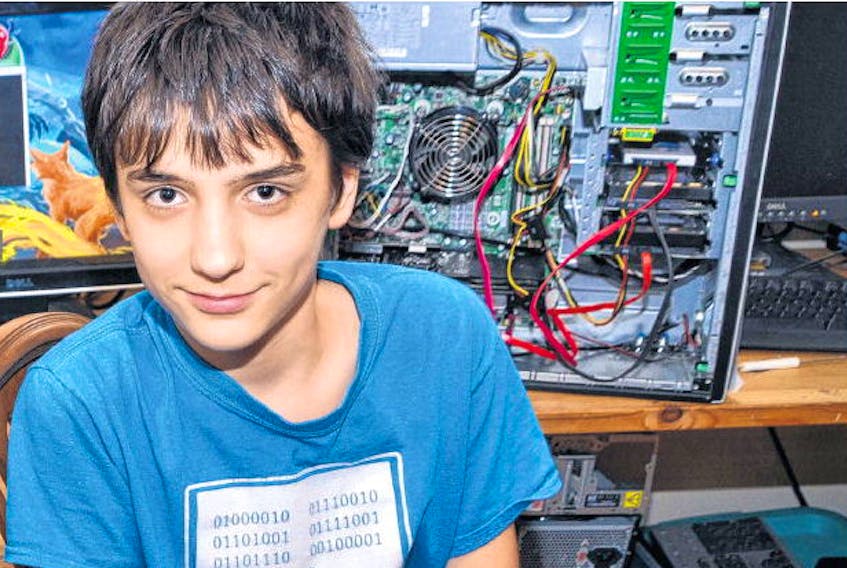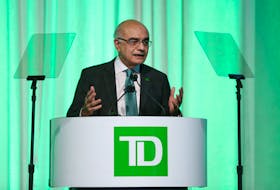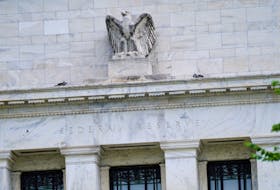At 11 years old, Jonas Tkacz is a mine manager savvy at digging up resources and wise with his pennies.
“I’m making about a dollar a day,” said Tkacz.
“But you have to account for electricity costs, which at 15 cents a kilowatt are about 30 cents a day.”
His mine, in an upstairs room of his parent’s house in Antigonish, is a computer he has assembled from parts foraged out of a dumpster at St. Francis Xavier University where his father, Greg, works as a professor of economics.
The prize jewel of his operation is a graphics card that was purchased new and allows his computer to “mine Bitcoins.”
Bitcoin miners create the cryptocurrency by solving complex mathematical puzzles. Since December, Tkacz’s computing power has allowed him to amass 0.00034240 Bitcoins — about $4.02 worth, according to what the cryptocurrency was trading at on Monday afternoon.
“I had near $20 worth when it was at its peak,” he said.
On Dec. 16, a single Bitcoin was trading at nearly $20,000 — up from $900 at the beginning of last year. That led to widespread speculation and hype around the currency that is created and governed by software on tens of thousands of computers around the world.
As excitement has spread around Bitcoin and other cryptocurrencies like it, so have the scams and pitfalls.
On Monday, the Nova Scotia Securities Commission issued a warning.
“There are legitimate investments in cryptocurrencies and initial coin offerings, but their sudden rise in popularity has also made them a breeding ground for scam artists and fraudsters,” reads the news release put out by the commission mandated with protecting this province’s investors.
This statement carries two interesting points — the first being the warning of widespread fraud piggybacking on all the Bitcoin hype, and the second being that cryptocurrency could be considered an investment.
Bank of Canada governor Stepehen Poloz addressed cryptocurrencies in a December speech.
“What their true value is may be anyone’s guess — perhaps the most one can say is that buying these things means buying risk, which makes it closer to gambling than investing,” he said.
“All I will say to people intending to buy a so-called cryptocurrency is that you should read the fine print and make sure you know what you are getting into.”
Because if there is no tangible asset backing a currency, or a nation’s economy to which it is tied, then are you buying something or gambling on the fact that more people will start trading in it and push the price up.
“If there was a security scare and people stopped trading in Bitcoin or moved to some other cryptocurrency with better security features, demand could drop,” said Greg Tkacz, who was a manager at the Bank of Canada before becoming a St. F.X. professor.
That leads him to call it gambling, rather than investing.
Asked what separates that from any other currency, Tkacz was quick with a response.
“The difference with a currency like Canada’s is that it is backed by the government. Your deposits are insured up to $100,000. Canadian dollars are used in transactions. You can’t pay your taxes in Bitcoin. Debts are settled in Canadian dollars.”
There is guaranteed activity in Canadian dollars so long as the Canadian economy exists.
Back upstairs in the mine, Jonas was asked if he would recommend investing in the currency.
“No. Over an hour the price can change by $700,” he said.
“When I’m mining, I’m not investing much in it. I can still sell my graphics card.”
But lots of other people have been investing huge amounts of money.
In December, Vancouver-based Hut 8 announced a partnership with Bitfury, which already has computer networks mining Bitcoins around the world that are so large that when combined they consume 172 megawatts of electricity.
Hut 8’s fully operational datacentres, to be based largely in Drumheller, Alta., will consume 200 megawatts of power.
They’re only one player in a great big cryptocurrency world that sees data processing power replacing the actual mining of resources from the earth as a generator of wealth.
Graphics card prices have gone up correspondingly — the GForce GTX 1080 TI, which Jonas had hoped to purchase, has gone from $700 last March to $1,200 today.
Instead, Jonas plans to buy three low-end cards and tie them together to increase his data processing power. As an 11-year-old, he isn’t risking fortunes. Bitcoin mining is something his computer does while he’s not using it.
And he’s busy with other things, like working on his “super computer,” which looks like a pile of electronic castoffs in a wicker basket and a milk carton.
They are the pieces of old computers the librarian at his school let him have after he fixed her VCR.
They’re all wired together in their separate baskets and, combined, give him the computing power of a new, low-end laptop.
“If I were going to invest real money in something, I would invest it in Google stock,” Jonas said. “Most of the other tech companies are just producing new renditions of old projects. (Google is) actually creating new technologies like Google Glass and selfdriving cars.”









